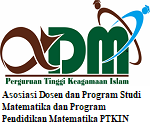Dynamics of SARS-CoV-2 Spread Model with Vaccine Administration and Use of Masks
DOI:
https://doi.org/10.15642/mantik.2022.8.1.18-27Keywords:
SARS-CoV-2, Vaccines, Use of masks, SIER model, Mathematical modelingAbstract
The purpose of this study was to construct and determine the dynamics of the mathematical model of the reach of SARS-CoV-2 with the provision of vaccines and the use of masks. In this study, the modified SEIR model was used with the stages of conducting a literature study on mathematical modeling of the SARS-CoV-2 virus, compiling initial assumptions, making compartment diagrams, constructing mathematical models, determining equilibrium points, determining basic reproduction numbers, conducting stability analysis and synchronization of analysis results by performing numerical simulations. In this study, two equilibrium points were obtained the disease-free equilibrium point and the endemic equilibrium point. Using the basic reproduction number, we get the stability conditions for the disease-free point and the endemic point. When the disease-free point is stable, SARS-CoV-2 will disappear from the population, while when the disease-free point unstable, SARS-CoV-2 will be exist’s in the population.
Downloads
References
N. S. Zhong et al., “Epidemiology and cause of severe acute respiratory syndrome.pdf,” Lancet(London,England), vol. 362, no. 9393, pp. 1353–1358, 2003.
WHO, “Middle East Respiratory Syndrome Coronavirus (MERS-CoV),” 2021. https://www.who.int/health-topics/middle-east-respiratory-syndrome-coronavirus-mers#tab=tab_1 (accessed Jan. 28, 2022).
B. Hu, H. Guo, P. Zhou, and Z. L. Shi, “Characteristics of SARS-CoV-2 and COVID-19,” Nat. Rev. Microbiol., vol. 19, no. 3, pp. 141–154, 2021, doi: 10.1038/s41579-020-00459-7.
D. Wu, T. Wu, Q. Liu, and Z. Yang, “The SARS-CoV-2 outbreak: What we know,” Int. J. Infect. Dis., vol. 94, pp. 44–48, 2020, doi: 10.1016/j.ijid.2020.03.004.
M. L. Diagne, H. Rwezaura, S. Y. Tchoumi, and J. M. Tchuenche, “A Mathematical Model of COVID-19 with Vaccination and Treatment,” Comput. Math. Methods Med., vol. 2021, 2021, doi: 10.1155/2021/1250129.
WHO, “Coronavirus Disease (COVID-19),” 2021. https://www.who.int/news-room/questions-and-answers/item/coronavirus-disease-covid-19-how-is-it-transmitted (accessed Dec. 25, 2021).
D. of V. Diseases, “Science Brief : Community Use of Mask to Control the Spread of SARS-CoV-2,” Centers for Diseases Control and Prevention, 2021. https://www.cdc.gov/coronavirus/2019-ncov/more/masking-science-sars-cov2.html (accessed Dec. 25, 2021).
D. K. Chu et al., “Physical distancing, face masks, and eye protection to prevent person-to-person transmission of SARS-CoV-2 and COVID-19: a systematic review and meta-analysis,” Lancet, vol. 395, no. 10242, pp. 1973–1987, 2020, doi: 10.1016/S0140-6736(20)31142-9.
E. Hall, A. P. Wodi, J. Hamborsky, V. Morelli, and S. Schilie, “Epidemiology and Prevention of Vaccine-Preventable Diseases,” D.C. Public Heal. Found., vol. 14, 2021, [Online]. Available: https://www.cdc.gov/vaccines/pubs/pinkbook/front-matter.html.
S. A. Nugroho and I. N. Hidayat, “Efektivitas dan Keamanan Vaksin Covid-19 : Studi Refrensi,” J. Keperawatan Prof., vol. 9, no. 2, 2021.
J. M. Carcione, J. E. Santos, C. Bagaini, and J. Ba, “A Simulation of a COVID-19 Epidemic Based on a Deterministic SEIR Model,” Front. Public Heal., vol. 8, no. May, 2020, doi: 10.3389/fpubh.2020.00230.
L. Peng, W. Yang, D. Zhang, C. Zhuge, and L. Hong, “Epidemic analysis of COVID-19 in China by dynamical modeling,” pp. 22–24, 2020, [Online]. Available: http://arxiv.org/abs/2002.06563.
M. S. P. Pramudito and B. P. Prawoto, “Model SEIR Penyakit COVID-19 Dengan Adanya Migrasi dan Pemberian Vaksin,” Mathunesa, vol. 09, no. 02, pp. 260–267, 2021.
M. Manaqib, I. Fauziah, and M. Mujiyanti, “Mathematical Model for MERS-COV Disease Transmission with Medical Mask Usage and Vaccination,” InPrime: Indonesian Journal of Pure and Applied Mathematics, vol. 1, no. 2. 2019, doi: 10.15408/inprime.v1i2.13553.
S. Annas, M. Isbar Pratama, M. Rifandi, W. Sanusi, and S. Side, “Stability analysis and numerical simulation of SEIR model for pandemic COVID-19 spread in Indonesia,” Chaos, Solitons and Fractals, vol. 139, 2020, doi: 10.1016/j.chaos.2020.110072.
J. Olsder, G., Mathematical Systems Theory. Delftse Uitgevers Maatscappij b.v., 2003.
O. Diekmann, J. A. P. Heesterbeek, and M. G. Roberts, “The construction of next-generation matrices for compartmental epidemic models,” J. R. Soc. Interface, vol. 7, no. 47, pp. 873–885, 2010, doi: 10.1098/rsif.2009.0386.
P. L. Delamater, E. J. Street, T. F. Leslie, Y. T. Yang, and K. H. Jacobsen, “Complexity of the basic reproduction number (R0),” Emerg. Infect. Dis., vol. 25, no. 1, pp. 1–4, 2019, doi: 10.3201/eid2501.171901.
R. Purnamandaru, Rezanissa Artiono, “Analisis Dinamik Model Koinfeksi Penyakit Rubella dan Covid-19,” Mathunesa, vol. 09, no. 02, pp. 332–343, 2021.
M. Manaqib, I. Fauziah, E. Hartati, M. Manaqib, I. Fauziah, and E. Hartati, “Model Matematika Penyebaran COVID-19 dengan Penggunaan Masker Kesehatan dan Karantina,” Jambura J. Biomath, vol. 2, no. 2, pp. 68–79, 2021.
Downloads
Published
How to Cite
Issue
Section
License
Copyright (c) 2022 Khofifah Ichawati, Budi Priyo Prawoto

This work is licensed under a Creative Commons Attribution-NonCommercial-ShareAlike 4.0 International License.
- Authors retain copyright and grant the journal right of first publication with the work simultaneously licensed under a Creative Commons License that allows others to share the work with an acknowledgment of the work's authorship and initial publication in this journal.
- Authors are able to enter into separate, additional contractual arrangements for the non-exclusive distribution of the journal's published version of the work (e.g., post it to an institutional repository or publish it in a book), with an acknowledgment of its initial publication in this journal.
- Authors are permitted and encouraged to post their work online (e.g., in institutional repositories or on their website) prior to and during the submission process, as it can lead to productive exchanges, as well as earlier and greater citation of published work







.png)




